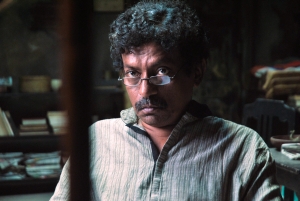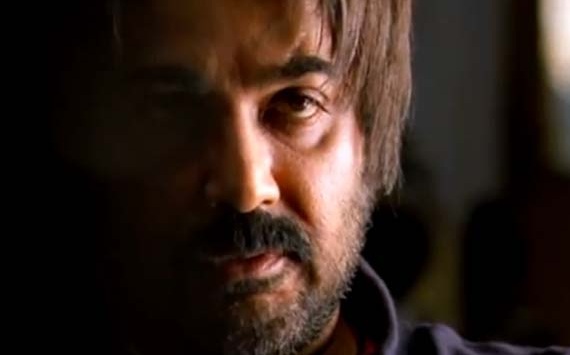Unmitigated Agonies and Unheard voices: Exploration of Madness in Srijit Mukherji’s Baishey Shrabon and Jatishwar
September 5, 2015
| By
Subham Dutta
In Baishe Srabon Srjit Mukherjee reflects on ‘mad’ characters and how they are treated by the society at large – for its use and desertion.

The mad poet (played by director Goutam Ghosh) in Baishe Srabon
The themes and motifs that Srijit’s films explore, despite not being unfamiliar to Bengali Cinephiles, carve a niche substantially because of the manner they are dealt with. Despite the occasional forays into the world of death, gloom and depression they barely recreate a Sen or a Ghatak on screen. Be the use of cinematic mis-en-scene or the delicate use of songs or the use of camera, Srijit always keeps the populist veneer intact through a unique stylization of the cinematic narrative. His penchant for excessive stylization helps him in getting a wider audience, across different age groups, predominantly the youth, nevertheless at times it becomes grossly superfluous and grates on one’s nerves.
A critical appraisal of Mukherji’s films, however, unfolds some common thematic aspects. Madness is a motif, Mukherji, has frequently dwelt on in his films. After Foucault it is well known that the idea of madness is a discursive construct. Deviation from the socially disciplined discourses tags one with the charge of madness. Srijit’s films obviously delve deeper into its exploration of madness to reveal how the identities of the so called mad characters are structured by the politics of power.

Prosenjit as Prabir in Baishe Srabon
Firstly Srijit’s success lies in rescuing it from the Bengali cultural amnesia. The cinematic narrative becomes intertexual with reference to Nibaran Chakrabarty from Tagore’s Shesher Kabita. Nibaran is projected as a deranged poet with the delusional worldview. Metaphorically, however, Nibaran’s narrative seems to explore the politics of mainstream Bengali Neo-Romantic poetry in suppressing the voices of dissent emerging from the margin. Hungry Realism’s obsession with crudity and vulgarity, moving away from the mushy sentimental narrative of Bengali Romantic poetry, was perhaps too scathing for the Bengali readers to endure.
Simultaneously, another narrative shows Prabir Roy Chowdhury, an ex police officer as one of the victims of the system. Prabir’s attempt to rise above the administrative loopholes makes him a victim of the system; he is suspended from the job being indicted with the charge of ‘madness’. Prabir’s resistance to be in complicity with the corrupt logic of the system tags levels him with the charge of madness to ostracize him from the system. But the twist comes when a series of murderers in Kolkata leaves the Police Force utterly confounded. They are forced to seek resort to the fertile brain of Prabir again to resolve these problems.
The narrative of a mad poet and a mad Police officer move together and coincide at a crucial juncture from where the film takes its climactic turn. The conversation between Prabir Roy Chowdhury and Nibaran Chakrabarty clearly explores the perversions of power and shows how they remain integrally embedded within the system. Their attitude to go against the grain whether it is through writing poetry against the popular stream or refusal to be in complicity with the corrupt bureaucratic system represents a form of transgression beyond the socially disciplined discourses. Baishey Srabon thereby very pertinently calls into the question the idea of madness and explores it to be ideologically governed.
The trope of madness is quite adroitly used in Srijit’s Jatishwar as well which is also one of his most critically acclaimed films. However its commercial success didn’t touch the height of Baishe Shrabon. Baishe Shrabon being a whodunit is made up of a series of interconnected cues, in which Bengali poetry plays a salient role. Though Srijit brilliantly arranges the plot with reference to the poetry of the ‘Hungry’ poets, the main narrative revolves around the search for the murderer as in a perfect whodunit. The way Prabir searches information about the poets on Google, it becomes pretty apparent that they are nothing more than forgotten faces in Bengali poetry. Though these references almost resuscitate an alternative poetic tradition through a popular medium, the reference to Bengali poetry remains tangential to the main narrative. It only provides the main plot its contours without coming in contact with it.
কোন মন্তব্য নেই:
একটি মন্তব্য পোস্ট করুন